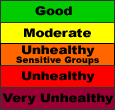July 5, 2012
As Dallas-Fort Worth braces for the long hot summer, ozone alert days are also popping into the forecast. Those are days when ozone levels are expected to rise to unhealthy levels as designated by Environmental Protection Agency standards.
There are two distinct ozone layers affecting the Earth. A layer of naturally occurring ozone gas forms about 10 miles up in the air, protecting the Earth from harmful ultraviolet rays. Man-made ozone is created at ground level when volatile organic compounds and nitrogen oxide pollutants “cook” with sunlight and heat. Low-wind and stagnant high-pressure systems are also factors. That’s why those hot, sunny, windless summer days produce ozone alerts.
The Dallas-Fort Worth region has a long history of being in nonattainment of ozone standards set by the EPA under the Clean Air Act.
However, Terry Clawson, spokesperson for the Texas Commission on Environmental Quality, said across the state, the air quality has steadily improved over the years despite development. Stricter vehicle inspection tests, cleaner cars on the road and industry regulations have helped bring the levels down.
“Last summer was bad. It interrupted that trend. However, we have every confidence, the downward trend will continue,” he said.
The current federal ozone level standard is 75 parts per billion while the 10-county North Texas region emits 87 ppb, a number based on a formula calculated and averaged over three years.
High concentrations of ozone can cause shortness of breath, coughing or wheezing, headaches, nausea or throat and lung irritation.
So far in 2012, the Dallas-Fort Worth area has had 13 days designated as Level Orange ozone days, which is considered unhealthy for sensitive people, including children and those with lung disease. The area has undergone two days at Level Red, defined as unhealthy for all. Last year, the region spent 40 days at Orange Level or above.
According to Shannon Stevenson, spokesperson for the North Central Texas Council of Governments, the DFW region has a tougher time than other metropolitan areas in the U.S. because of its climate plus its position downwind from outside sources of pollution, such as Houston and the power plants south and east of Dallas.
Ozone levels are tracked by 20 monitors scattered across North Texas. The air quality typically varies across the Metroplex. Those areas with significant pollution sources such as industrial plants or heavy traffic may have higher readings. However, wind is a factor and can blow ozone into or out of an area resulting in even rural areas with high readings. (See current ozone readings.)
According to NCTCOG, as much as 49 percent of emissions that contribute to ozone in DFW comes from cars and trucks. Nonroad engine sources, which includes construction equipment, airplanes, trains and lawnmowers, account for 27 percent. Industry sources, such as cement kilns, power plants and chemical plants, produce 14 percent. Commercial businesses, such as dry cleaners, paint shops and bakeries, make up 5 percent. An additional 5 percent comes from oil and gas drilling and production, a new category being tracked.
Stevenson said in the past, monitors in the north Dallas and Frisco areas have had the highest readings of the region but the plume seems to be shifting west. Now the Keller and Eagle Mountain Lake areas are topping the list. Researchers say the high ozone levels could be due to wind patterns. However, there’s also speculation that it’s caused by gas drilling in the Barnett Shale.
Jim Schermbeck, director of Downwinders at Risk, an air-quality watchdog group, is concerned that gas drilling is contributing to increased ozone levels.
“The further east the drilling goes, we’re seeing that the monitors are tripping,” he said. “It’s circumstantial evidence but it suggests there’s a correlation between the rise of gas drilling and rise of ozone levels surrounding those sites.”
Schermbeck is a member of Dallas Residents at Risk, a coalition that includes the Dallas Sierra Club and Texas Campaign for the Environment. The group is pushing for the city of Dallas to require the gas industry to offset its emissions, providing the industry with an incentive to further reduce them. Schermbeck, who has led efforts over two decades to force cement plants in Ellis County to curb ozone-producing emissions, added that both cement and coal plants should do more to cap pollutants.
Stevenson said while the NCTCOG does not have authority to regulate local industry, it is making efforts to reduce ozone levels in North Texas with programs geared to mobile sources of pollution.
“I’m happy to say, we’re doing a lot,” said Stevenson. “There’s a ton of
programs aimed at reducing emissions.”
Since 2009, NCTCOG and the Regional Transportation Council have awarded $20 million in American Recovery and Reinvestment Act grants to purchase alternative fuel vehicles, upgrade vehicles with emissions-reducing technologies and build alternative fuel infrastructure
$20 million in American Recovery and Reinvestment Act grants to purchase alternative fuel vehicles, upgrade vehicles with emissions-reducing technologies and build alternative fuel infrastructure
(Photo: Mass transit options are one way in which NTCOG and other organizations will seek to clean up Dallas's air)
Other efforts include implementing idling restrictions for trucks, upgrading school buses and educating the public on how they can reduce ozone.
On July 7, NCTCOG is hosting a Clean Air Day, between 7 a.m. and 7 p.m., to encourage residents to make pollution-reducing choices such as car pooling, biking instead of driving or telecommuting.
Stevenson said these acts are small steps but if more people change their habits, real change could result.
“We’ve already reached out for the low-hanging fruit,” she said. “To get to that next level, everyone’s going to have to pitch in.”
For more information on air quality in Texas, including ozone maps, alternative fueling stations and grant programs, seewww.nctcog.org and www.tceq.state.tx.us.
Stay up to date on everything green in North Texas, including the latest news and events! Sign up for the weekly Green Source DFW Newsletter! Follow us on Facebook and Twitter.









